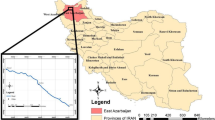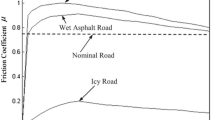Abstract
This paper discusses how to identify tire model coefficients that are used to compare longitudinal forces when braking. Those in the automotive world have worked extremely hard to obtain these parameters and different methods have been used to match the values of these parameters. This paper proposes the use of self-organizing maps to tackle this problem whereby interactively searches are carried out to find the optimum tire model parameters. The objective of this research is to prove the capability of self-organizing maps (SOMs) to classify a vehicle’s braking formula on a roller brake tester from the MOT (Ministry of Transport) and on flat ground. The neural network produced a good brake-slip ratio when presented with data that are not used in network training. This means that the methodology is feasible. This tool easily obtains the brake-slip equation of each experiment and the braking on two different experimental tests will be compared.







Similar content being viewed by others
References
Pacejka HB, Bakker E (1993) The magic formula tire model. Veh Syst Dyn 21:1–18
Tohmaz AS, Hassan AE (1995) Application of artificial neural networks to skidder traction performance. J Terramech 32(3):105–114
Hebb DO, Wiley HK (1949) The organization of behavior, Wiley, New York, 67–68
Rosenblatt F (1989) The Perceptron: a probabilistic model for information storage and organization in the brain, Neurocomputing: Foundation of Research, MIT Press, Cambridge, 92–113
Widrow B, Lehr MA (1989) 10 years of adaptive neural networks: perceptron, madaline and backpropagation in the brain, neurocomputing: foundation of research. MIT Press, Cambridge, pp 92–113
Kohonen T (1982) Self-organized formation of topologically correct feature maps Biol Cybern 43(1):59–69. doi:10.1007/BF00337288
Senabre C, Velasco E, Sanchez M (2005) Study of mathematical models that simulate the movement of the tire and its interaction with the ground, TMT international conference
Pacejka HB, Besselink IJM (1997) Magic formula tire model with transient properties. Veh Syst Dyn Suppl 27:234–249
Kohonen T (1989) Self-Organization and Associative Memory, 3rd edn, Berlin, Germany, Springer, Helsinki University of Technology, SOM Toolbox for Matlab 5.0., [Online]. Available: www.cis.hut.fi/projects/somtoolbox/download
Luque P, Álvarez D, Vera C (2004) Automobile Engineering, Systems and Dynamic Performance, Thomson
Aparicio F, Vera C (2001) Teoría de los vehículos automóviles (2) (Theory of automobiles), p 69
Dixon JC (1996) Tires, suspension and handling, society of automotive engineers, Inc. The Open University, Great Britain, p 1996
Acknowledgments
We would like to thank the (Ministry of Transport) MOT station in Alicante and the Universidad Miguel Hernández for its cooperation and support during the research program.
Author information
Authors and Affiliations
Corresponding author
Rights and permissions
About this article
Cite this article
Senabre, C., Velasco, E. & Valero, S. “Self-organizing maps” for identification of tire model longitudinal braking parameters of a vehicle on a roller brake tester and on flat ground. Neural Comput & Applic 21, 1775–1782 (2012). https://doi.org/10.1007/s00521-011-0666-7
Received:
Accepted:
Published:
Issue Date:
DOI: https://doi.org/10.1007/s00521-011-0666-7




